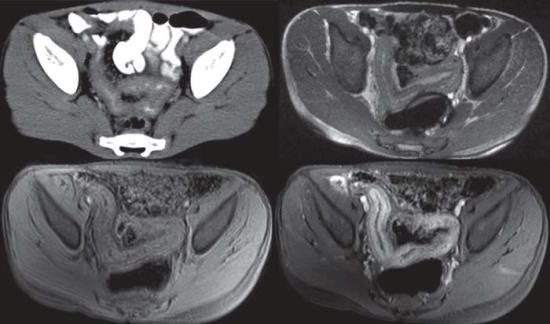MRI Enterography Preferred for Children with IBD
Magnetic resonance enterography should be the imaging method of choice for radiologists diagnosing children with inflammatory bowel diseases, a new study published online in the American Journal of Roentgenology argues.
Magnetic resonance enterography should be the imaging method of choice for radiologists diagnosing children with inflammatory bowel diseases, a new study published online in the American Journal of Roentgenology argues.
In a pictorial essay, Majid Chalian, MD, and colleagues at Johns Hopkins University said computed tomography (CT) has proven its value for the evaluation of IBD especially because this cross-sectional imaging technique allows identification of both intra- and extraluminal lesions and complications. But the high radiation dose limits its use in the pediatric population. They wrote that MRI “seems to be exquisitely well suited for the diagnostic workup of children with IBD” as a result.
New developments in MR enterography have been key, they said. Until recently, MRI was limited by long acquisition times and a lack of oral contrast agents that could adequately distend the bowel. With the development of fast T1- and T2-weighted MRI sequences and hyperosmolar biphasic (i.e., T1 hypointense, T2 hyperintense) oral contrast agents like barium preparation or polyethylene glycol, high-resolution images of the bowel can now be acquired. The simultaneous IV injection of glucagon further enhances image quality because bowel motion is suppressed.

The researchers further said MR enterography provides superior soft-tissue contrast, renders multiple imaging contrasts, can be acquired in multiple planes, gives an excellent depiction of fluid and edema, allows accurate differentiation of inflammatory strictures from fibrostenotic strictures, and has a high sensitivity for detecting mucosal changes.
Preliminary studies have shown that MR enterography has a sensitivity and specificity for IBD similar to CT enterography and is more sensitive for IBD than small-bowel follow-through studies, the researchers noted. In addition, MR enterography is preferred by patients because it causes less abdominal discomfort and nausea.
“MR enterography should be the primary cross-sectional imaging modality in children evaluated for IBD,” the researchers concluded. “CT should be considered only if there are absolute contraindications for an MRI examination (e.g., pacemaker).”
Inflammatory bowel diseases (IBDs) including Crohn disease and ulcerative colitis are chronic inflammatory diseases of the gastrointestinal. IBD has been reported to have an overall prevalence of 16.6 cases per 100,000 children and 5.3 cases per 100,000 children younger than 16 years old. Crohn disease is twice as common in children as ulcerative colitis
Study: Monitoring of Prostate MRI Exams Could Lead to 75 Percent Reduction of Gadolinium Contrast
March 17th 2025While DCE MRI was deemed helpful in over 67 percent of cases in which it was used, researchers found that monitored prostate MRI exams, which facilitated a 75 percent reduction of DCE MRI sequences, had comparable sensitivity for prostate cancer as non-monitored exams.